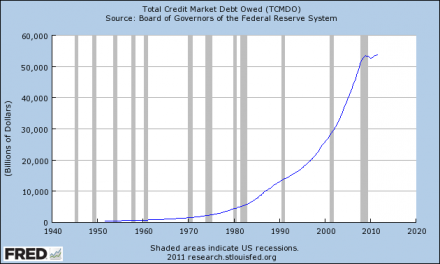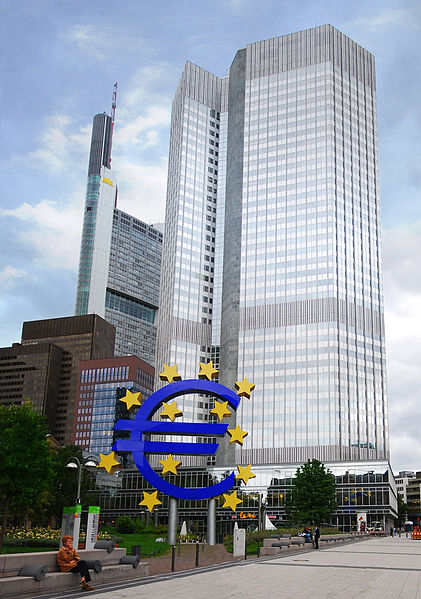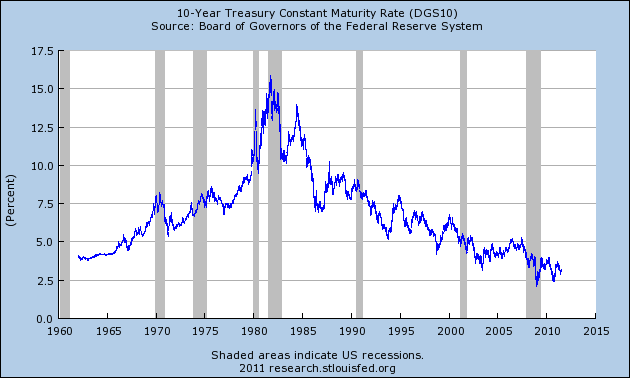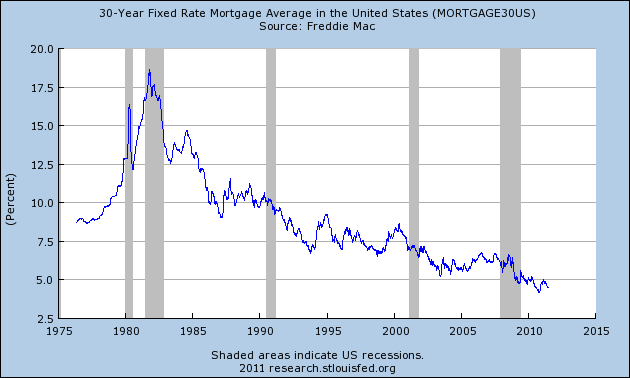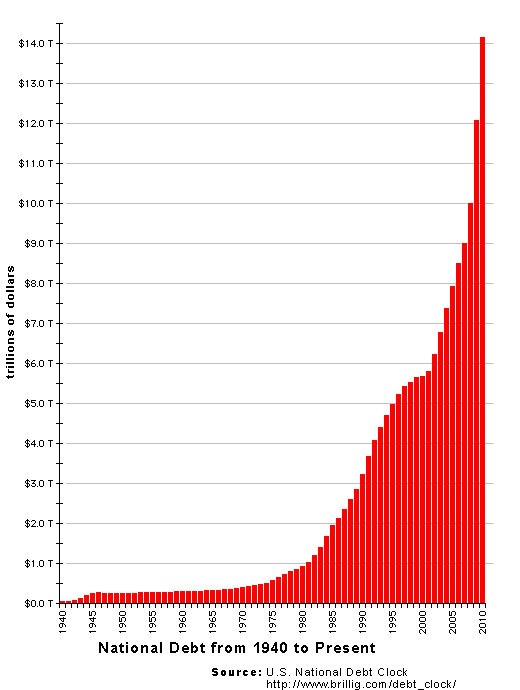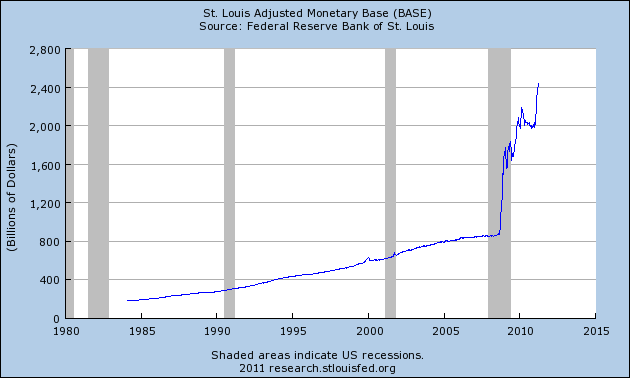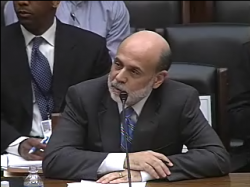 If you increased your credit card spending by a couple thousand dollars per month would your lifestyle improve? Of course it would. By going into large amounts of debt, it is possible to live a lifestyle that you can’t really afford, at least for a while. But if you keep racking up huge amounts of credit card debt every single month, eventually it gets to a point where it is extremely difficult to even keep up with the minimum monthly payments and the credit card companies will not lend you any more money. Well, on a larger scale it is the same thing with government debt. Right now, the U.S. government is spending more than a trillion dollars more than it takes in every year. Even if the U.S. government spends all of that money on incredibly stupid stuff, it still gets into the pockets of ordinary Americans. In turn, those ordinary Americans use that money to pay the mortgage, buy food, shop at the mall, etc. All of this borrowing and spending by the U.S. government has created a “false prosperity” bubble that is not real. It may feel real to you right now, but it is unsustainable by definition. If the U.S. government suddenly started spending only the money that it actually brought in every year, our economy would be doomed and all of this “false prosperity” would rapidly disappear. But if the U.S. government continues to rack up debt at this pace we are doomed as well. In fact, every dollar that gets borrowed makes our eventual collapse ever worse. We are heading down the exact same road that Greece has gone. Eventually the rest of the world is not going to lend us gigantic mountains of super cheap money anymore. When the flow of cheap money stops, it can be extremely painful. Anyone that has ever seen the interest rates on their credit cards go above 20 percent knows how this feels. If we had addressed these problems as a nation a decade or two ago, perhaps we could have found a solution. But now there is no way out under our current financial system and a devastating economic collapse is on the horizon no matter what we do.
If you increased your credit card spending by a couple thousand dollars per month would your lifestyle improve? Of course it would. By going into large amounts of debt, it is possible to live a lifestyle that you can’t really afford, at least for a while. But if you keep racking up huge amounts of credit card debt every single month, eventually it gets to a point where it is extremely difficult to even keep up with the minimum monthly payments and the credit card companies will not lend you any more money. Well, on a larger scale it is the same thing with government debt. Right now, the U.S. government is spending more than a trillion dollars more than it takes in every year. Even if the U.S. government spends all of that money on incredibly stupid stuff, it still gets into the pockets of ordinary Americans. In turn, those ordinary Americans use that money to pay the mortgage, buy food, shop at the mall, etc. All of this borrowing and spending by the U.S. government has created a “false prosperity” bubble that is not real. It may feel real to you right now, but it is unsustainable by definition. If the U.S. government suddenly started spending only the money that it actually brought in every year, our economy would be doomed and all of this “false prosperity” would rapidly disappear. But if the U.S. government continues to rack up debt at this pace we are doomed as well. In fact, every dollar that gets borrowed makes our eventual collapse ever worse. We are heading down the exact same road that Greece has gone. Eventually the rest of the world is not going to lend us gigantic mountains of super cheap money anymore. When the flow of cheap money stops, it can be extremely painful. Anyone that has ever seen the interest rates on their credit cards go above 20 percent knows how this feels. If we had addressed these problems as a nation a decade or two ago, perhaps we could have found a solution. But now there is no way out under our current financial system and a devastating economic collapse is on the horizon no matter what we do.
If there was a Hollywood movie where some crooks successfully stole 150 million dollars, what would you think of those crooks?
Would you have admiration for them?
Would you be disgusted with them?
Would you feel like your intelligence was insulted because nobody could ever steal 150 million dollars and get away with it?
Well, right now the federal government is stealing approximately 150 million dollars from our children and our grandchildren every single hour.
That’s right – the U.S. government is borrowing an astounding 150 million dollars an hour that our children and our grandchildren will be expected to deal with.
It is a theft so vast that it is almost unimaginable.
So what should be done?
A lot of people out there think that our problems would be solved if the government would just quit borrowing so much money.
Well, it is just not that simple.
Look at Greece. They were forced by the EU and the IMF to dramatically reduce government spending. But when Greece reduced government spending, that caused the economy to shrink rapidly and it caused tax receipts to go down more than expected. So Greek budget deficits were even larger than anticipated and so Greece was forced to cut spending even more. But that created even more economic problems.
A recent article by John Mauldin described the nightmarish effect that this cycle has had on Greece….
And as Greece began shake and bake its way to “austerity,” the very act of cutting deficits pushed the country into recession, which lowered tax revenues and increased expenses, putting the elusive goal of a balanced budget even further off. We should quickly note that this is not just a Greek problem. Spain’s “draconian” cuts have meant that its 6% deficit target for the year has this week been raised to a more likely 8%, making it harder to get back to even.
For country after country, this is the Endgame. It is the end of the Debt Supercycle. Debt has grown to the size that it cannot be sustained. The market will not lend any more money on terms that can be afforded, and any efforts to cut spending and raise taxes will result in an even worse economy, in various degrees of recession, with falling revenues and rising costs.
This is what happens when a country that has been spending far beyond its means is forced to dramatically cut back.
Those that are convinced that balancing the federal budget in the United States will be relatively painless should take a close look at what is happening in Greece.
As I have written about previously, the Greek economy has been plunged into a 21st century “Great Depression”. In Greece, 20 percent of all retail stores have already shut down, the unemployment rate for those under the age of 24 is sitting at 39 percent, and one third of the entire nation is living in poverty.
And this is only just the beginning for Greece.
Things are going to get even worse.
Unfortunately, many believe that the United States is destined to experience far worse pain than Greece is currently experiencing.
For example, Peter Schiff insists that the United States is in worse financial shape than Europe at this point. Just check out this video….
Anyone that attempts to downplay the U.S. debt problem is making a serious mistake. Yes, we are still able to borrow trillions of dollars for next to nothing, but that is going to come to an end.
Remember all of those “suckers” that signed up for mortgages at “teaser rates” that later got jacked up dramatically?
Of course you do.
So what happened to them?
When the rates went up many of them ended up losing everything.
Well, we have gotten ourselves into the exact same kind of a position. All of this cheap money has enabled us to live very nicely for now, but when the cheap money ends the nightmare will begin.
Right now, our debt is growing much, much faster than our economy is. Between 2007 and 2010, U.S. GDP grew by only 4.26%, but the U.S. national debt soared by 61% during that same time period.
What would your household finances look like if your total debt grew by 61 percent next year but your income only grew by 4 percent?
When I was a little boy, the U.S. national debt was considered to be a huge national crisis. Politicians from both major political parties were promising that they would fix things.
But what has happened since then?
Well, when Ronald Reagan took office the U.S. national debt was less than 1 trillion dollars. Today, the U.S. national debt is over 15.2 trillion dollars.
During 2011, the federal government went into more debt than the U.S. government accumulated from the time that George Washington became president to the time that Ronald Reagan became president.
That may be hard to believe, but it is true.
During fiscal year 2011, the U.S. government spent 3.7 trillion dollars but it only brought in 2.4 trillion dollars.
That is utter insanity, and yet most Americans have become convinced that this is “normal” and that there is nothing to worry about.
It is hard to grasp how much money a trillion dollars is.
If right this moment you went out and started spending one dollar every single second, it would take you more than 31,000 years to spend one trillion dollars.
That is how much money a trillion dollars is.
And things look even worse when you look at the balance sheet of the U.S. government.
The U.S. government has total assets of 2.7 trillion dollars and has total liabilities of 17.5 trillion dollars. Those liabilities do not even count 4.7 trillion dollars of intragovernmental debt that is currently outstanding.
But it is not just the federal government that has been living a fantasy.
The chart posted below shows the growth of total debt in America over the past several decades. Consumers, businesses and government officials have been on a debt binge that is absolutely unprecedented….
The scary thing is that even with all of this borrowed money, our economy is still in the dumps.
So what in the world is it going to look like when the debt bubble totally bursts?
Even with all of this “borrowed prosperity”, anger at the government is rapidly growing. A recent Gallup poll found that “satisfaction with government” in the United States is now at an all-time record low of 29 percent.
So how angry will the American people be when all of this “borrowed prosperity” disappears?
When this whole thing comes tumbling down, a lot of people are going to blame our problems on “capitalism”.
In fact, it is already happening. Just check out what the founder of the World Economic Forum is saying….
“We have a general morality gap, we are over-leveraged, we have neglected to invest in the future, we have undermined social coherence, and we are in danger of completely losing the confidence of future generations,” said Klaus Schwab, host and founder of the annual World Economic Forum.
“Solving problems in the context of outdated and crumbling models will only dig us deeper into the hole.
“We are in an era of profound change that urgently requires new ways of thinking instead of more business-as-usual,” the 73-year-old said, adding that “capitalism in its current form, has no place in the world around us.”
But capitalism is not the problem. Capitalism has produced the greatest eras of prosperity that the world has ever seen.
No, the real problem is our debt-based financial system that is managed and run by the central banks of the world.
You see, debt-based central banking is not capitalism. But way too many people equate the two.
A lot of people cannot even imagine this, but theoretically you could have capitalism without any debt whatsoever.
But what we have today is a financial system that has debt as the very foundation. And such a system is inevitably going to fail someday.
As I have written about so many times before, the Federal Reserve is at the very heart of our economic problems here in the United States.
The Federal Reserve was designed to be a perpetual debt machine. And it has performed that task very well. The U.S. national debt is now more than 5000 times larger than it was when the Federal Reserve was first created.
So yes, even though things seem somewhat “stable” for the moment, there are all kinds of reasons to be concerned about the viability of our economy and our financial system in the years ahead.
The other day, I was quoted in a Reuters article about our coming economic problems….
“Most people have a gut feeling that something has gone terribly wrong, but that doesn’t mean that they understand what is happening,” he said. “A lot of Americans sense that a massive economic storm is coming and they want to be prepared for it.”
Of course the Reuters reporter did not even bother to spell my name correctly, but at least he got the quote right.
A great economic storm is coming.
Don’t let this false prosperity and this “calm before the storm” fool you.
We are living in the greatest debt bubble the world has ever seen, and no matter how it plays out there is going to be a massive amount of pain.
You might want to get yourself and your family prepared for that.
